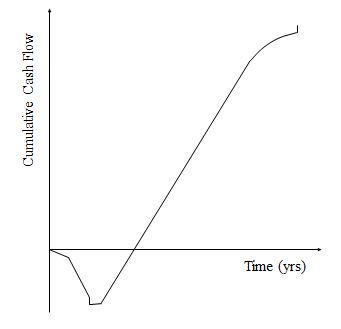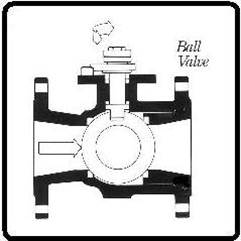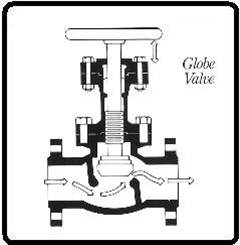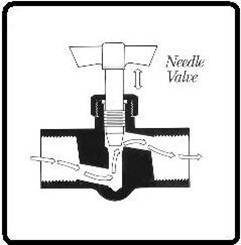Process hydraulics: Difference between revisions
Sean Kelton (talk | contribs) (→Valves) |
Sean Kelton (talk | contribs) (→Valves) |
||
| Line 68: | Line 68: | ||
[[File:Example5.jpg]] | [[File:Example5.jpg]] | ||
[[File:Example6.jpg]] | ===Globe Valve=== | ||
[[File:Example6.jpg]] | |||
===Needle Valve=== | ===Needle Valve=== | ||
Revision as of 01:55, 8 February 2014
Authors: Thomas Considine, Sean Kelton, Michael Gleeson
Introduction
The transportation and storage of fluids is essential to a chemical process plant. Piping, valves, pumps and compressors comprise the major components of fluid handling equipment. The goal of process hydraulics in a design setting is to overcome frictional losses in piping and equipment, provide correct operating conditions, and overall assist in the controls of the plant. All three objectives must be design in concert, and before the final controls system is designed. (Towler, 1207).
Hydraulic systems & Pressure drop
Overall pressure drops created by pumps and compressors must also include those created by the connecting pipes. These components must be designed in concert, to account for changes in elevation and friction losses in the pipe.
Total Pressure Drop
Pressure drops throughout the flow of a fluid can be summed to find the overall pressure drop of a defined system. For example: If a fluid A, initially at zero gauge pressure, is pumped to a pressure of 300 kPa, then flows through 10 meters of pipe resulting in a loss of 50 kPa, the final gauge pressure at the end of the pipe is 250 kPa. This type of analysis is useful when designing pressure systems over many components.
Pressure Drop in Pipes
When designing pumps and compressors, the loss of pressure due to piping is not negligible, and must be appropriately accounted for (Turton, 537). The pressure change in pressure across a pipe is calculated as follows:
where and are specific coefficient (typically 0.005 for turbulent flows), the length of piping, the diameter of piping, the density of the fluid, and the velocity of the fluid.
An added term accounting for the pressure difference due to height is also necessary if there is a change in elevation.
Additionally, the first term in the equation can be altered to include an additional factor:
which accounts for piping bends, restrictions, and other variables.
Heuristics
Both the process hydraulics and the economics of a system is affected by pipe sizing (Peters, 500). Heuristics, or "Rules-of-thumbs" have been developed to assist in optimizing pipe selection. While more detailed optimization techniques are available and commonly used, the rules of thumb provide a good starting point for pipe selection.
Suggested pipe velocities, in ft/s, for gases, liquids, and super-heated steam are approximately 60-100, 6, and 150, respectively (Towler Presentation, 9). Additionally, for liquid flow, the following equation provides a rule-of-thumb for optimal pipe diameter, in inches:
Where D is the optimal diameter, and Flow is in units of gallons/minute.
Pumps & Compressors
Guys: I cited Towler in our introduction, and then Turton and Peters (light grey and new-but-not-our-book)
TJ: Check out (Seider, 132) (the dark grey book) for a pumps/compressor rule of thumb
Valves
A valve is a mechanical tool used to control the flow of material in a system by blocking or restricting the materials flow path; typically used on piping. Valves serve many purposes including but not limited to: beginning or quenching the flow of a material through a system, regulating the flow rate of the material traveling through a system, regulating the pressure of a material flowing through a system, prevent back-flow of a material and changing the flow direction at intersection points.
Gate Valve
A gate valve is comprised of a wedge that slides up and down perpendicular to the path of fluid flow on screw type mechanism, which spins in opposite directions to open/close the valve, in order to allow and block fluid flow respectively. This type of valve is an ON/OFF valve and therefore should either be operated fully open or fully closed. Operating partially open can degrade the seal on the valve. The fluid path is straight through the valve and therefore minimal pressure drop results.
Ball Valve
A ball valve is another type of ON/OFF valve that only operates fully opened or closed with the flow path straight through the valve. However, these valves only require a quarter turn to open or close the valve and therefore can quench flow much faster than a gate valve. Rather than blocking flow with a wedge, a ball valve turns so that the opening aligns with the pipe to allow flow or pipe wall to block flow.
Butterfly Valve
A butterfly valve also requires only a quarter turn to switch between the open and closed position. A flat plate switches positions between being parallel or perpendicular to flow in order to allow or prevent flow through the valve respectively. This valve does not seal well on its own and, unaided, can be pushed open by fluid flow, therefore extra materials are required for complete shutdown of flow.
Plug Valve
Globe Valve
Needle Valve
Control Valve
Check Valve
File:Example9.jpg
File:Example10.jpg

Guys: I cited Towler in our introduction, and then Turton and Peters (light grey and new-but-not-our-book)











